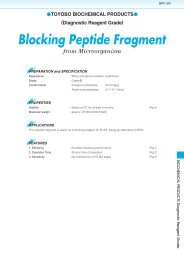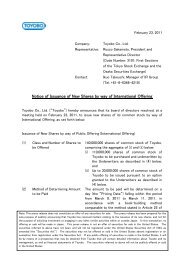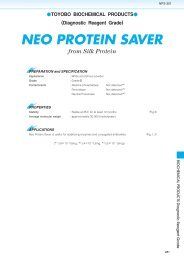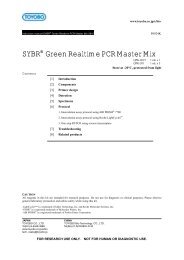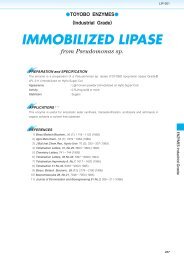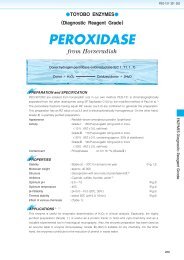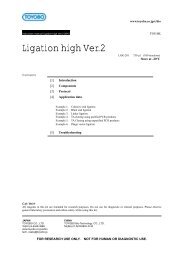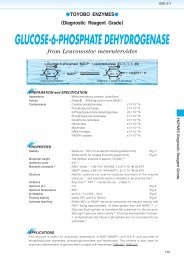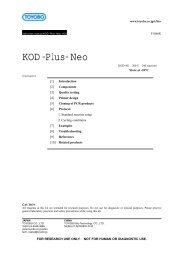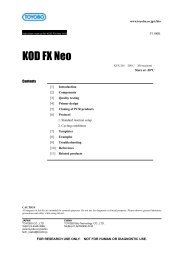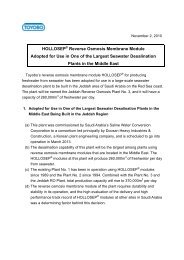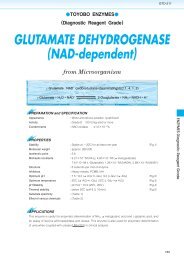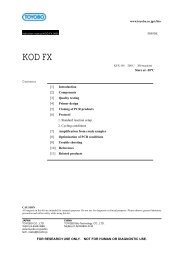LCD-211 - Toyobo
LCD-211 - Toyobo
LCD-211 - Toyobo
Create successful ePaper yourself
Turn your PDF publications into a flip-book with our unique Google optimized e-Paper software.
<strong>LCD</strong>-<strong>211</strong><br />
TOYOBO ENZYMES<br />
(Diagnostic Reagent Grade)<br />
D-LACTATE DEHYDROGENASE<br />
from Microorganism<br />
(R)-Lactate : NAD + oxidoreductase (EC 1. 1. 1. 28)<br />
D-LactateNAD + PyruvateNADH H +<br />
PREPARATION and SPECIFICATION<br />
Appearance<br />
: White amorphous powder, lyophilized<br />
Activity<br />
: Grade400U/mg-solid or more<br />
Contaminants : NADH oxidase ≤1.010 3 %<br />
Malate dehydrogenase ≤1.010 2 %<br />
GOT ≤5.010 3 %<br />
GPT ≤5.010 3 %<br />
Myokinase ≤1.010 2 %<br />
Pyruvate kinase ≤1.010 3 %<br />
PROPERTIES<br />
Stability : Store at 20 Fig.1<br />
Molecular weight<br />
: approx. 140,000 (by gel filtration)<br />
Isoelectric point : 4.0<br />
Michaelis constant : 1.610 4 M (pyruvate, pH 7.0)<br />
Inhibitors<br />
: Ag , Hg , SH-reagents<br />
Optimum pH : 6.07.0 Fig.2<br />
Optimum temperature : 3540 Fig.3<br />
pH Stability : pH 5.09.0 (25, 48hr) Fig.4<br />
Thermal stability : below 45 (pH 7.0, 15min) Fig.5<br />
Effect of various chemicals : (Table 1)<br />
APPLICATIONS<br />
This enzyme is useful for enzymatic determination of numerous metabolites, e.g.ATP, ADP, glucose,<br />
creatinine, pyruvate, lactate and glycerol, and of enzyme activities, e.g.GPT, PK and CPK when coupled<br />
with the related enzymes.
<strong>LCD</strong>-<strong>211</strong><br />
ASSAY<br />
Principle:<br />
PyruvateNADHH <br />
D-lactate dehydrogenase<br />
D-LactateNAD <br />
The disappearance of NADH is measured at 340nm by spectrophotometry.<br />
Unit definition:<br />
One unit causes the oxidation of one micromole of NADH per minute under the conditions described below.<br />
Method:<br />
Reagents<br />
A. Pyruvate solution<br />
5.0mM5.50mg sodium pyruvate (MW110)/10ml of H 2 O(Should be<br />
prepared fresh)<br />
B. K-Phosphate buffer, pH 7.4<br />
C. NADH solution<br />
D. Enzyme diluent<br />
1.0M<br />
1.0mM7.63mg NADH2Na (MW763)/10ml of H 2 O(Should be prepared fresh)<br />
0.1M K-phosphate buffer, pH 7.4 contg. 0.1% of BSA<br />
Procedure<br />
1. Prepare the following working solution (10 tests) in a brownish<br />
bottle, immediately before use and store on ice.<br />
3.0ml Substrate solution (A)<br />
2.0ml K-Phosphate buffer, pH 7.4 (B)<br />
3.0ml NADH solution (C)<br />
22.0ml H 2 O (D)<br />
Concentration in assay mixture<br />
K-Phosphate buffer<br />
Pyruvate<br />
NADH<br />
BSA<br />
67 mM<br />
0.49 mM<br />
0.098mM<br />
16.4g/ml<br />
2. Pipette 3.0ml of working solution into a cuvette (d1.0cm) and equilibrate at 25 for about 5 minutes.<br />
3. Add 0.05ml of the enzyme solution and mix by gentle inversion.<br />
4. Record the decrease in optical density at 340nm against water for 2 to 3 minutes in a spectrophotometer<br />
thermostated at 25, and calculate the OD per minute from the initial linear portion of the curve (OD<br />
test).<br />
At the same time, measure the blank rate (OD blank) by using the same method as the test except that<br />
the enzyme diluent is added instead of the enzyme solution.<br />
<br />
Dilute the enzyme preparation to 0.21.0U/ml with ice-cold enzyme diluent (D), immediately before<br />
Calculation<br />
assay.<br />
Activity can be calculated by using the following formula<br />
OD/min (OD testOD blank)Vtdf<br />
Volume activity (U/ml) <br />
6.221.0Vs<br />
Weight activity (U/mg)(U/ml)1/C<br />
Vt Total volume (3.05ml)<br />
Vs Sample volume (0.05ml)<br />
6.22 Millimolar extinction coefficient of NADH (F/micromole)<br />
1.0 Light path length (cm)<br />
df Dilution factor<br />
C Enzyme concentration in dissolution (c mg/ml)<br />
OD/min9.81df<br />
REFERENCES<br />
1) C.A.Loshon, R.B.McComb, L.W.Bond, G.N.Bowers, Jr.W.H.Coleman and R.H.Gwynn; Clin.Chem., 23, 1576<br />
(1977).<br />
2) H.Taguchi, M.Machida, H.Matsuzawa and T.Ohta; Agric.Biol.Chem., 49 (2), 359 (1985).<br />
3) F.Gasser, M.Doudoroff, and R.Contopoulos; J.Gen.Microbiol. 62, 241 (1970).
<strong>LCD</strong>-<strong>211</strong><br />
Table 1. Effect of Various Chemicals on D-Lactate dehydrogenase<br />
The enzyme dissolved in 0.1M K-Phosphate buffer, pH 7.4 (20U/ml)was incubated with each chemical at 25<br />
for 1hr.<br />
Chemical<br />
None<br />
Metal salt<br />
MgCl 2<br />
CaCl 2<br />
Ba(OAc) 2<br />
FeCl 2<br />
CoCl 2<br />
MnCl 2<br />
ZnSO 4<br />
Cd(OAc) 2<br />
NiCl 2<br />
CuSO 4<br />
Pb(OAc) 2<br />
AgNO 3<br />
HgCl 2<br />
Concn.(mM)<br />
Residual<br />
activity<br />
100%<br />
2.0<br />
93.0<br />
99.8<br />
98.1<br />
87.9<br />
91.5<br />
92.2<br />
89.6<br />
91.3<br />
92.6<br />
93.8<br />
93.2<br />
73.0<br />
0<br />
Chemical<br />
PCMB<br />
MIA<br />
NaF<br />
NaN 3<br />
EDTA<br />
o-Phenanthroline<br />
,-Dipyridyl<br />
Borate<br />
IAA<br />
NEM<br />
Hydroxylamine<br />
Triton X-100<br />
Brij 35<br />
Tween 20<br />
Span 20<br />
Na-cholate<br />
SDS<br />
DAC<br />
Concn.(mM)<br />
2.0<br />
2.0<br />
2.0<br />
20<br />
5.0<br />
2.0<br />
1.0<br />
50<br />
2.0<br />
2.0<br />
2.0<br />
0.10%<br />
0.10%<br />
0.10%<br />
0.10%<br />
0.10%<br />
0.05%<br />
0.05%<br />
Ac, CH 3 CO; PCMB, p-Chloromercuribenzoate; MIA, Monoiodoacetate; EDTA, Ethylenediaminetetraacetate;<br />
IAA, Iodoacetamide; NEM, N-Ethylmaleimide; SDS, Sodium dodecyl sulfate;<br />
DAC, Dimethyl-benzyl-alkyl-ammonium chloride.<br />
Residual<br />
activity<br />
89.3<br />
0.1<br />
98.3<br />
94.6<br />
99.2<br />
95.3<br />
93.7<br />
95.6<br />
33.6<br />
97.7<br />
95.6<br />
121<br />
116<br />
117<br />
105<br />
112<br />
109<br />
52.0<br />
100<br />
100<br />
100<br />
Residual Activity,%<br />
50<br />
-20<br />
35<br />
Relative Activity<br />
50<br />
Residual Activity,%<br />
50<br />
0 1 2 3 12<br />
(weeks) Period (months)<br />
Fig.1. Stability (Powder form)<br />
kept under dry conditions<br />
0 4 5 6 7 8 9<br />
pH<br />
Fig.2. pH-Activity<br />
in 67mM buffer solution; pH 4-5,<br />
acetate;pH5-8,K-phosphate;pH8-9<br />
Tris-HCI<br />
0 4 5 6 7 8 9 10<br />
pH<br />
Fig.4. pH-Stability<br />
25,48hr-treatment with 0.1M buffer<br />
solution: pH 4-6, dimethylgutaric<br />
acid-NaOH;pH6-8, K-phosphate; pH<br />
8-9,Tris-HCI; pH9-10,glycine-NaOH.<br />
enzyme concn.: 10U/ml<br />
100<br />
100<br />
Relative Activity<br />
50<br />
Residual Activity,%<br />
50<br />
0 20 30 40 50<br />
0 35 40 45 50 55<br />
Temperature, <br />
Temperature, <br />
Fig.3. Temperature activity<br />
Fig.5. Temperature stability<br />
in 67mM K-phosphate buffer, pH7.4<br />
15 min-treatment with 50mM<br />
K-phosphate buffer,pH7.0.enzyme<br />
concn.: 10U/ml
<strong>LCD</strong>-<strong>211</strong><br />
<br />
<br />
<br />
<br />
<br />
<br />
<br />
<br />
<br />
<br />
<br />
<br />
<br />
<br />
<br />
P<br />
P<br />
<br />
<br />
<br />
P <br />
P <br />
P <br />
P 2 <br />
P<br />
<br />
P<br />
<br />
<br />
<br />
P<br />
<br />
P<br />
<br />
<br />
D-lactate dehydrogenase<br />
P<br />
P<br />
P <br />
<br />
P <br />
<br />
<br />
<br />
P



